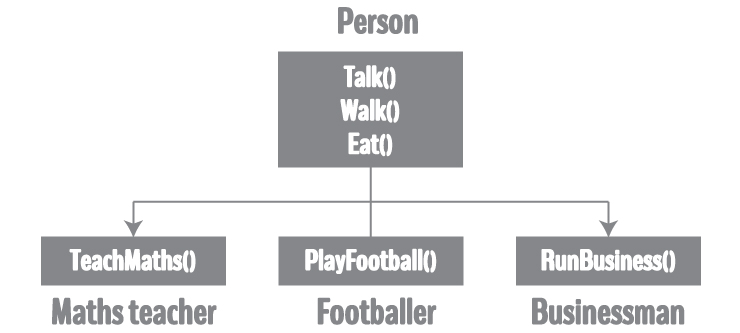在本文中,您将学习有关 C++ 中继承的所有知识。 更具体地说,继承是什么以及通过示例实现继承的不同方法。
继承是 C++ 中面向对象编程的主要功能之一。 它允许用户从现有的类(基类)创建一个新的类(派生类)。
派生类继承了基类的所有功能,并且可以拥有自己的其他功能。
为什么要使用继承?
假设您在游戏中需要三个角色-数学老师,足球运动员和商人。
由于所有角色都是人,因此他们可以走路和说话。 但是,他们也有一些特殊技能。 数学老师可以教数学,足球运动员可以踢足球,商人可以经营企业。
您可以单独创建三个可以走路,说话和执行其特殊技能的类,如下图所示。

在每个类中,您将为每个角色复制相同的步行和交谈代码。
如果要添加新函数eat,则需要为每个字符实现相同的代码。 这很容易导致出错(复制时)和重复代码。
如果我们有一个Person类,它具有基本的功能,例如说话,走路,吃饭,睡觉,并根据我们的角色向这些功能添加特殊技能,那就容易得多。 这是使用继承完成的。

使用继承,现在您不必为每个类实现相同的代码。 您只需要继承它们即可。
因此,对于数学老师(派生类),您可以继承Person(基类)的所有函数并添加新函数TeachMaths。 同样,对于足球运动员,您继承了Person的所有函数并添加了新函数PlayFootball,依此类推。
这使您的代码更简洁,易于理解和可扩展。
重要的是要记住:在处理继承时,每个派生类都应满足“是”基类的条件。 在上面的示例中,数学老师是人,足球先生是人。 您不能拥有:商人是企业。
C++ 编程中继承的实现
class Person{... .. ...};class MathsTeacher : public Person{... .. ...};class Footballer : public Person{.... .. ...};
在以上示例中,类别Person是基类,类别MathsTeacher和Footballer是从Person派生的。
派生的类与类的声明一起显示,后跟冒号,关键字public和派生该类的基类的名称。
由于MathsTeacher和Footballer源自Person,因此可以从中访问Person的所有数据成员和成员函数。
示例:C++ 编程中的继承
使用继承概念创建游戏角色。
#include <iostream>using namespace std;class Person{public:string profession;int age;Person(): profession("unemployed"), age(16) { }void display(){cout << "My profession is: " << profession << endl;cout << "My age is: " << age << endl;walk();talk();}void walk() { cout << "I can walk." << endl; }void talk() { cout << "I can talk." << endl; }};// MathsTeacher class is derived from base class Person.class MathsTeacher : public Person{public:void teachMaths() { cout << "I can teach Maths." << endl; }};// Footballer class is derived from base class Person.class Footballer : public Person{public:void playFootball() { cout << "I can play Football." << endl; }};int main(){MathsTeacher teacher;teacher.profession = "Teacher";teacher.age = 23;teacher.display();teacher.teachMaths();Footballer footballer;footballer.profession = "Footballer";footballer.age = 19;footballer.display();footballer.playFootball();return 0;}
输出
My profession is: Teacher
My age is: 23
I can walk.
I can talk.
I can teach Maths.
My profession is: Footballer
My age is: 19
I can walk.
I can talk.
I can play Football.
在此程序中,Person是基类,而MathsTeacher和Footballer是从Person派生的。
Person类具有两个数据成员 - profession和age。 它还具有两个成员函数-walk()和talk()。
MathsTeacher和Footballer都可以访问Person的所有数据成员和成员函数。
但是,MathsTeacher和Footballer也具有自己的成员函数:分别为teachMaths()和playFootball()。 这些函数只能由自己的类访问。
在main()函数中,创建了一个新的MathsTeacher对象Teacher。
由于可以访问Person的数据成员,因此设置了Teacher的profession和age。 使用在Person类中定义的display()函数显示此数据。 此外,将调用MathsTeacher类中定义的teachMaths()函数。
同样,还将创建一个新的Footballer对象footballer。 它也可以访问Person的数据成员,这可以通过调用display()函数来显示。 然后,只有足球运动员才能使用的playFootball()函数被调用。
继承中的访问说明符
从基类创建派生类时,可以使用不同的访问说明符来继承基类的数据成员。
这些可以是公共的,受保护的或私有的。
在以上示例中,基类Person已由MathsTeacher和Footballer公开继承。
了解有关 C++ 中的公共,保护和私有继承的更多信息。
继承中的成员函数覆盖
假设基类和派生类的成员函数具有相同的名称和参数。
如果创建派生类的对象并尝试访问该成员函数,则仅调用派生类中的成员函数。
派生类的成员函数将覆盖基类的成员函数。
了解有关 C++ 中的函数覆盖的更多信息。

